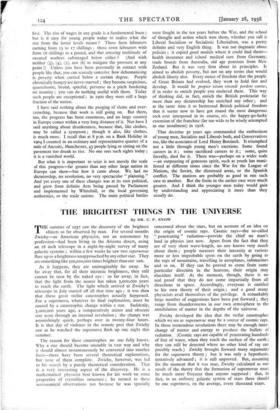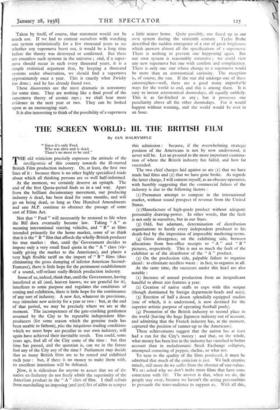THE BRIGHTEST THINGS IN THE UNIVERSE
By DR. C. P. SNOW
THE summer of 1937 saw the discovery of the brightest objects so far observed by man. For several months Zwicky—an American physicist, not an astronomer by profession—had been living in the Arizona desert, using an 18 inch telescope in a night-by-night survey of many galactic systems ; within a few weeks he saw two supernovae flare up to a brightness unapproached by any other star. They are something like 500,000,000 times brighter than our sun.
As it happens, they are unimaginably far away. So far away that, for all their intrinsic brightness, they still cannot be seen by the naked eye : so far away, in fact, that the light from the nearer has taken 3,000,000 years to reach the earth. The light which arrived at Zwicky's telescope in July started off all that time ago ; it was then that these great stellar catastrophes actually happened. For a supernova, whatever its final explanation, must be caused by a catastrophic change within a star. Suddenly, 3,000,000 years ago, a comparatively minor and obscure star went through an internal revolution ; the change was astonishingly quick, perhaps over in twenty-four hours. It is that day of violence in the remote past that Zwicky saw as he watched the supernova flash up one night this summer.
The reason for these catastrophes no one fully knows. Why a star should become unstable in teat way and why it should almost instantaneously be converted into another form—there have been several theoretical explanations, but none of them complete. Zwicky, however, was led to his search by a -purely theoretical consideration. That is a very interesting aspect of the discovery. He is a mathematical physicist best known for his work on some properties of crystalline structure ; he turned to these astronomical observations not because he was specially concerned about the stars, but on account of an idea on the origin of cosmic rays. Cosmic rays—the so-called " penetrating " radiation—provide the chief no man's land in physics just now. Apart from the fact that they are of very short wave-length, no one knows very much about them ; people measure their intensity at various more or less improbable spots on the earth by going to the tops of mountains, travelling in aeroplanes, submarines and so on. If they can be proved to come from some particular direction in the heavens, their origin may elucidate itself. At the moment, though, there is no real proof that they do not come impartially from all directions in space. Accordingly, everyone is entitled to his own theory of their origin ; and a good many physicists avail themselves of the privilege. A remarkably large number of suggestions have been put forward ; they range from thunderstorms in our own atmosphere to the annihilation of matter in the depths of the universe.
Zwicky developed the idea that the stellar catastrophes which we see as supernovae may be a source of cosmic rays. In those tremendous revolutions there may be enough inter- change of matter and energy to produce the bullets of radiation. (Cosmic rays are capable of penetrating hundreds of feet of water, when they reach the surface of the earth ; they can still be detected where no other kind of ray can possibly reach.) Zwicky brought forward many arguments for the supernova theory ; but it was only a hypothesis, tentatively advanced ; it is still unproved. But, assuming for the moment that it was true, Zwicky calculated as one result of the theory that the formation of supernovae must be much more frequent than anyone supposed : that, in fact, in an ordinary galactic system of stars there should be one supernova, on the average, every thousand years. Taken by itself, of course, that statement would not be much use. If we had to content ourselves with watching one system optimistically for a few thousand years to see whether any supernova burst out, it would be a long time before the theory was destroyed or confirmed. But there are countless such systems in the universe ; and, if a super- nova should occur in each every thousand years, it is a simple statistical argument that, by keeping a thousand systems under observation, we should find a supernova approximately once a year. This is exactly what Zwicky has done ; and he has already found two.
These discoveries are the most dramatic in astronomy for some time. They are nothing like a final proof of the supernova theory of cosmic rays ; we shall hear more evidence in the next year or two. They can be looked upon as an encouraging start.
It is also interesting to think of the possibility of a supernova a little nearer home. Quite possibly, one flared up in our own system during the sixteenth century. Tycho Brahe described the sudden emergence of a star of great brightness which answers almost all the specifications of 3 supernova. There is nothing to prevent one happening" again. But our own system is reasonably extensive ; we could view any new supernova but one with comfort and complacency. There is only one star whose change to a supernova would be more than an astronomical curiosity. The exception is, of course, the sun. If the star did undergo one of these catastrophes—well, there are a good many improbable ways for the world to end, and this i.; among them. It is easy to invent astronomical doomsdays, all equally unlikely. This is as far-fetched as any ; but it possesses one peculiarity above all the other doomsdays. For it would happen without warning, and the world would be over in an hour.



















































 Previous page
Previous page